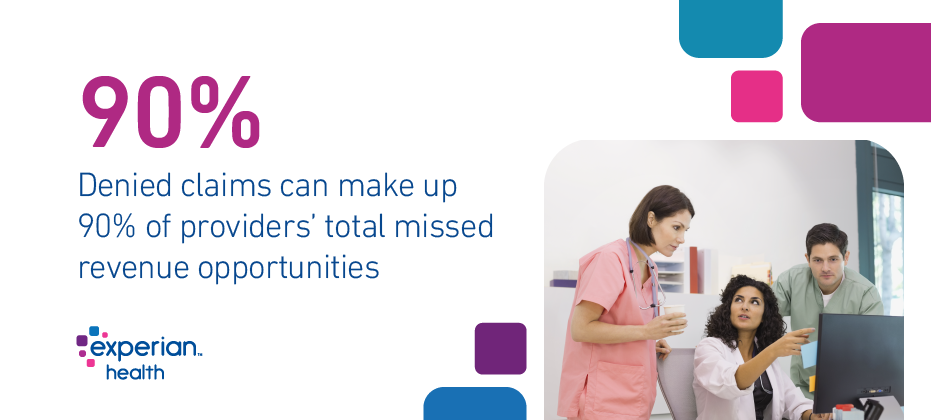
Did you know a whopping 90% of missed revenue opportunities can be linked to denied claims?
At a time when providers are working to make up this lost revenue, they are also dealing with patients who are expected to cover more of their medical bills through out-of-pocket expenses. High-deductible health plans, free-care programs and crowdfunding are more prominent, leaving hospitals vulnerable to the patient’s ability to pay. Add in the rise of value-based care, and it’s no secret patients expect an experience that matches their interactions with other consumer services. They’re more engaged in their health and know they have options.
Patient collections are down, but expectations are up. Loyalty wavers somewhere in the middle. How should providers respond?
Legacy revenue systems aren’t set up for financial models based on value over volume, so providers need to adapt. It’s vital to find ways to help patients navigate the financial side of healthcare and make patient collection processes as efficient as possible.
What does value-based care mean for your revenue cycle?
Shifting to value-based reimbursements, patient-centric incentives and quality of care programs means your clinical and revenue cycle workflows need to be better connected. Patients must receive consistent and accurate communications throughout their healthcare journey, setting them up for the best possible health outcome and payment options. When the care and finance functions work together, your patient records can be kept up to date and the next admin task will be triggered at the right time.
Here are some things your revenue cycle management (RCM) process might be missing:
- clear and convenient processes for patients
- accurate patient identification from registration to billing
- ability to collaborate with payers to customize workflows
- streamlined workflows to reduce time and resources spent on avoidable tasks
- automated processes to support effective collections and spot root causes of denials
- real-time reporting to help improve performance over time
[Source: Frost and Sullivan]
Data, analytics and automation can help you create more agile processes to minimize revenue leakage and create a better financial experience for patients.
3 ways to close the gaps in a value-based RCM model
1. Use consumer data to help patients make informed decisions
A major cause of denied claims stems from patients being unsure about what their treatment will cost. Others are unclear about whether they have appropriate coverage. Help your patients weigh their financial options by providing accurate estimates and working with them to check coverage.
Consumer data can support this process by giving you insights into your patient’s social identity, medical history, coverage status, insurance eligibility and propensity to pay. With an intuitive billing process, you’ll improve the patient payment experience and reduce revenue leakage.
2. Use analytics to predict gaps in your revenue cycle
Many top-performing health systems use advanced data analytics to predict where the bottlenecks, errors and denials might creep in, so they can take swift action to address them and keep their patients and C-suite happy.
For example, with analytics, you can get to know your patients better so you can segment them according to their financial responsibility and ability to pay. Not only does this mean you can focus your collections efforts more effectively, but you’ll have the right insights to help patients navigate the payment process with personalized nudges and relevant messaging.
In addition, analytics have a huge role to play in eliminating avoidable denials resulting from unreliable or inaccurate patient data. You’ll be able to spot patterns in denials, so you can implement checks and processes to avoid them in future.
3. Put the right tools in place to close the gaps
Close the widening gap between claims and collections starts by ensuring your patients are aware of their financial responsibility. A self-service patient portal could give your patients convenient access to their information in a time and place that suits them. They’ll be able to schedule appointments, enroll in payment plans, and apply for charity. They’ll see real-time, transparent and accurate information about price estimates and their eligibility and coverage. When the financial experience is transparent and frictionless, patients are more likely to feel satisfied and less likely to shop around for care – not to mention being better prepared to meet payment deadlines.
And internally, data-driven automated software can help you monitor and manage every step of your revenue cycle. You can make life easier for clinicians and management teams with EHR-integrated dashboards, web-based financial reporting and timely alerts for the relevant teams. Schneck Medical Center used Experian Health’s Denials Workflow Manager to automate tedious manual processes, freeing up staff time and optimizing claims follow-up and collection:
“No longer are we waiting 30 to 45 days to review denials. We can review them on the day of [submitting] if we choose to.” (McKenzie Smith, Director of Patient Financial Services)
It’s simply no longer viable to use RCM processes that aren’t integrated across your entire digital ecosystem. Providers that can offer a convenient and personalized consumer experience, automate collections workflows and join the dots between clinical care and revenue management will have the competitive advantage in the era of value-based care.
Learn more about how your organization can use data to predict and close gaps in your revenue cycle.


